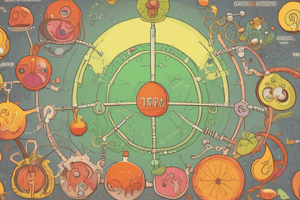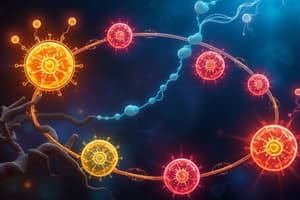Podcast
Questions and Answers
Which of the following best describes the primary function of the citric acid cycle (CAC)?
Which of the following best describes the primary function of the citric acid cycle (CAC)?
- To generate glucose from non-carbohydrate precursors.
- To synthesize fatty acids from excess carbohydrates.
- To directly phosphorylate CAC intermediates to produce ATP.
- To oxidize acetyl-CoA completely, producing $CO_2$, $H_2O$, NADH, $FADH_2$, and GTP. (correct)
During which reaction of the citric acid cycle (CAC) is GTP produced via substrate-level phosphorylation?
During which reaction of the citric acid cycle (CAC) is GTP produced via substrate-level phosphorylation?
- Conversion of fumarate to malate.
- Conversion of isocitrate to $\alpha$-ketoglutarate.
- Conversion of succinyl-CoA to succinate. (correct)
- Conversion of malate to oxaloacetate.
Which enzyme catalyzes the reaction that produces $FADH_2$ in the citric acid cycle (CAC)?
Which enzyme catalyzes the reaction that produces $FADH_2$ in the citric acid cycle (CAC)?
- $\alpha$-Ketoglutarate dehydrogenase.
- Malate dehydrogenase.
- Isocitrate dehydrogenase.
- Succinate dehydrogenase. (correct)
What is the direct product of the reaction catalyzed by fumarase in the citric acid cycle?
What is the direct product of the reaction catalyzed by fumarase in the citric acid cycle?
Which of the following enzymes catalyzes an oxidative decarboxylation reaction in the citric acid cycle (CAC)?
Which of the following enzymes catalyzes an oxidative decarboxylation reaction in the citric acid cycle (CAC)?
Which of the following is the correct order of electron carriers in the electron transport chain (ETC)?
Which of the following is the correct order of electron carriers in the electron transport chain (ETC)?
Which complex of the electron transport chain (ETC) does not directly contribute to the proton gradient?
Which complex of the electron transport chain (ETC) does not directly contribute to the proton gradient?
Which mobile electron carrier transfers electrons from Complex III to Complex IV in the electron transport chain?
Which mobile electron carrier transfers electrons from Complex III to Complex IV in the electron transport chain?
Which of the following is the primary role of the proton gradient generated by the electron transport chain (ETC)?
Which of the following is the primary role of the proton gradient generated by the electron transport chain (ETC)?
What is the P/O ratio for $FADH_2$? In other words, how many ATP molecules are produced per molecule of $O_2$ consumed when electrons are donated by $FADH_2$?
What is the P/O ratio for $FADH_2$? In other words, how many ATP molecules are produced per molecule of $O_2$ consumed when electrons are donated by $FADH_2$?
Which of the following statements accurately describes the regulation of the citric acid cycle (CAC)?
Which of the following statements accurately describes the regulation of the citric acid cycle (CAC)?
How does an increase in the concentration of acetyl-CoA typically affect pyruvate carboxylase activity?
How does an increase in the concentration of acetyl-CoA typically affect pyruvate carboxylase activity?
What is the term for the process of replenishing citric acid cycle (CAC) intermediates that have been used for biosynthesis?
What is the term for the process of replenishing citric acid cycle (CAC) intermediates that have been used for biosynthesis?
Under normal physiological conditions, how many ATP molecules (or GTP equivalents) are produced by each molecule of acetyl-CoA that enters the citric acid cycle (CAC)?
Under normal physiological conditions, how many ATP molecules (or GTP equivalents) are produced by each molecule of acetyl-CoA that enters the citric acid cycle (CAC)?
Which of the following metabolic intermediates can be derived from carbon skeletons entering the citric acid cycle at $\alpha$-ketoglutarate?
Which of the following metabolic intermediates can be derived from carbon skeletons entering the citric acid cycle at $\alpha$-ketoglutarate?
Which of the following is a common characteristic found in both the pyruvate dehydrogenase complex and the $\alpha$-ketoglutarate dehydrogenase complex?
Which of the following is a common characteristic found in both the pyruvate dehydrogenase complex and the $\alpha$-ketoglutarate dehydrogenase complex?
What role do iron-sulfur (Fe-S) proteins play in the electron transport chain (ETC)?
What role do iron-sulfur (Fe-S) proteins play in the electron transport chain (ETC)?
According to the chemiosmotic theory, how is the energy obtained when electrons pass from a high free energy state to a lower free energy state used?
According to the chemiosmotic theory, how is the energy obtained when electrons pass from a high free energy state to a lower free energy state used?
Which of the following is a key difference between heme iron in cytochromes compared to heme iron in hemoglobin?
Which of the following is a key difference between heme iron in cytochromes compared to heme iron in hemoglobin?
Why is the inner mitochondrial membrane impermeable to NADH produced in the cytoplasm, and how is this issue overcome?
Why is the inner mitochondrial membrane impermeable to NADH produced in the cytoplasm, and how is this issue overcome?
What is the primary function of the ATP/ADP translocase located in the inner mitochondrial membrane?
What is the primary function of the ATP/ADP translocase located in the inner mitochondrial membrane?
How does fluoroacetate act as a poison?
How does fluoroacetate act as a poison?
What is the effect of uncouplers like dinitrophenol on the electron transport chain (ETC) and ATP synthesis?
What is the effect of uncouplers like dinitrophenol on the electron transport chain (ETC) and ATP synthesis?
How does cyanide inhibit electron transport?
How does cyanide inhibit electron transport?
What is the effect of oligomycin on electron transport and ATP synthesis?
What is the effect of oligomycin on electron transport and ATP synthesis?
Which of the following is a characteristic feature of the malate-aspartate shuttle?
Which of the following is a characteristic feature of the malate-aspartate shuttle?
What is the role of glycerol 3-phosphate dehydrogenase (GPDH) in the glycerol phosphate shuttle?
What is the role of glycerol 3-phosphate dehydrogenase (GPDH) in the glycerol phosphate shuttle?
What is the effect of increased ADP concentration on electron transport and oxidative phosphorylation?
What is the effect of increased ADP concentration on electron transport and oxidative phosphorylation?
Which of the following statements best describes the concept of respiratory control in oxidative phosphorylation?
Which of the following statements best describes the concept of respiratory control in oxidative phosphorylation?
Which component of the ATP synthase complex actually binds ADP and $P_i$ to synthesize ATP?
Which component of the ATP synthase complex actually binds ADP and $P_i$ to synthesize ATP?
How does atractyloside inhibit ATP synthesis?
How does atractyloside inhibit ATP synthesis?
Which of the following is a direct symptom of Leber hereditary optic neuropathy?
Which of the following is a direct symptom of Leber hereditary optic neuropathy?
Which of the following is characteristic of mitochondrial DNA?
Which of the following is characteristic of mitochondrial DNA?
In which of the following locations does the malate-aspartate shuttle regenerate NADH?
In which of the following locations does the malate-aspartate shuttle regenerate NADH?
Cyanide and carbon monoxide both inhibit the electron transport chain by directly affecting which complex?
Cyanide and carbon monoxide both inhibit the electron transport chain by directly affecting which complex?
How does the inhibition of aconitase by fluorocitrate impact the citric acid cycle?
How does the inhibition of aconitase by fluorocitrate impact the citric acid cycle?
Which of the following best describes the overall effect of pentachlorophenol on cellular metabolism?
Which of the following best describes the overall effect of pentachlorophenol on cellular metabolism?
A defect in which enzyme would affect both the citric acid cycle and the electron transport chain?
A defect in which enzyme would affect both the citric acid cycle and the electron transport chain?
Which statement correctly describes the effect of inhibiting ATP/ADP translocase on cellular metabolism?
Which statement correctly describes the effect of inhibiting ATP/ADP translocase on cellular metabolism?
Flashcards
Citric Acid Cycle (CAC)
Citric Acid Cycle (CAC)
The citric acid cycle, oxidizing acetyl-CoA to CO2 and H2O, yielding NADH, FADH2, and GTP.
Pyruvate Carboxylase
Pyruvate Carboxylase
Converts pyruvate to oxaloacetate (OAA), replenishing OAA for the CAC.
NADH-Q Reductase
NADH-Q Reductase
A mitochondrial complex transferring electrons from NADH to coenzyme Q, using FMN.
Succinate-Q Reductase
Succinate-Q Reductase
Signup and view all the flashcards
Coenzyme Q (Ubiquinone)
Coenzyme Q (Ubiquinone)
Signup and view all the flashcards
Cytochrome C Reductase
Cytochrome C Reductase
Signup and view all the flashcards
Cytochrome C
Cytochrome C
Signup and view all the flashcards
Cytochrome Oxidase
Cytochrome Oxidase
Signup and view all the flashcards
Electron Transport Chain
Electron Transport Chain
Signup and view all the flashcards
ATP Synthase Complex
ATP Synthase Complex
Signup and view all the flashcards
Zidovudine (AZT)
Zidovudine (AZT)
Signup and view all the flashcards
Antimycin A
Antimycin A
Signup and view all the flashcards
Uncouplers
Uncouplers
Signup and view all the flashcards
Atractyloside
Atractyloside
Signup and view all the flashcards
P/O Ratio
P/O Ratio
Signup and view all the flashcards
Isocitrate Dehydrogenase (IDH)
Isocitrate Dehydrogenase (IDH)
Signup and view all the flashcards
Anaplerosis
Anaplerosis
Signup and view all the flashcards
Anaplerotic reaction
Anaplerotic reaction
Signup and view all the flashcards
Citric Acid Cycle
Citric Acid Cycle
Signup and view all the flashcards
Complexes I, III, IV
Complexes I, III, IV
Signup and view all the flashcards
Lipophilic organic acids
Lipophilic organic acids
Signup and view all the flashcards
Proton Gradient
Proton Gradient
Signup and view all the flashcards
KGDC
KGDC
Signup and view all the flashcards
Study Notes
- These notes pertain to the citric acid cycle, electron transport chain, and oxidative phosphorylation.
Pathway Reaction Steps
- The citric acid cycle (CAC) oxidizes a 2-carbon acetyl-coenzyme A (CoA) molecule, yielding energy in the forms of NADH, FADH2, and GTP.
- Unlike the glycolytic pathway, the CAC does not involve phosphorylated intermediates.
- The CAC comprises reactions that assimilate acetyl-CoA and remove its carbon atoms as CO2 to produce succinate, and reactions that convert succinate back to oxaloacetate (OAA).
- Acetyl-CoA condenses with OAA to form citrate, catalyzed by citrate synthetase.
- Citrate is isomerized to isocitrate via cis-aconitate, an enzyme-bound intermediate, by aconitase.
- Isocitrate undergoes oxidative decarboxylation by isocitrate dehydrogenase, yielding α-ketoglutarate, CO2, and NADH.
- α-Ketoglutarate undergoes oxidative decarboxylation by α-ketoglutarate dehydrogenase, producing succinyl-CoA, CO2, and NADH.
- Succinyl-CoA is converted to succinate by succinate thiokinase, with the removal of CoA and substrate-level phosphorylation of GDP to GTP.
- Succinate is oxidized to fumarate by succinate dehydrogenase, producing FADH2; this enzyme is part of the succinate-Q reductase (complex II) in the electron transport chain (ETC).
- The double bond in fumarate is hydrated to form malate by fumarase.
- Malate is oxidized to OAA by malate dehydrogenase, producing NADH, which regenerates OAA to condense with another molecule of acetyl-CoA.
Electron Transport Chain and Oxidative Phosphorylation
- In the electron transport chain and oxidative phosphorylation, electrons and protons are the primary products and reactants.
- The protons produced during electron transport are pumped from the mitochondrial matrix to the inner membrane space, creating a proton gradient.
- All enzyme complexes in the ETC and ATP synthesis are embedded in the inner mitochondrial membrane, isolating them from the cytoplasm while exposing them to matrix metabolites like ADP and NADH.
Mitochondria as Symbionts
- Exchange between the mitochondrial matrix and the cytoplasm is highly selective and requires specific transporters.
- Mitochondria have circular DNA and prokaryotic ribosomes, supporting the idea of a symbiotic prokaryotic origin.
- The process of mitochondrial DNA replication and fission into daughter mitochondria is for separate regulation of cytoplasmic and mitochondrial metabolism.
- Mitochondria are not true symbionts, as most of mitochondrial proteins are specified by nuclear DNA.
Key Points About the Citric Acid Cycle
- The CAC releases carbons from acetyl-CoA as CO2 and produces NADH, FADH2, and GTP.
- The CAC has three regulatory points, with isocitrate dehydrogenase (IDH) being the most important, controlled by ATP and NADH levels.
- The CAC functions as a metabolic traffic circle, receiving carbon skeletons from amino acids and fatty acids while donating them to amino acids and porphyrins.
- Pyruvate carboxylase converts pyruvate to OAA when the flow of acetyl-CoA into the CAC increases, providing substrate to combine with acetyl-CoA.
Electron Transport Chain Components
- NADH-Q reductase (complex I) transfers electrons from NADH in the mitochondrial matrix to coenzyme Q via flavin mononucleotide (FMN).
- Succinate-Q reductase (complex II) transfers electrons from FADH2 to coenzyme Q and includes succinate dehydrogenase, glycerol-3-phosphate dehydrogenase, and fatty acyl-CoA dehydrogenase, all with FAD as a prosthetic group.
- Coenzyme Q (ubiquinone), a lipid-soluble quinone, accepts electrons from complex I and II and carries them through the inner mitochondrial membrane to cytochrome c reductase (complex III).
- Cytochrome c reductase (complex III) accepts electrons from coenzyme Q and donates them to cytochrome c; its protein components include cytochrome b and cytochrome c1.
- Cytochrome c, a water-soluble protein, diffuses along the intermembrane space to transfer electrons from complex III to complex IV.
- Cytochrome oxidase (complex IV) transfers electrons from cytochrome c to O2, contains cytochromes a and a3, and uses copper as a component.
Proton Pumping and ATP Synthesis
- Complexes I, III, and IV pump protons into the intermembrane space for every pair of electrons that they transport to O2, maintaining a proton concentration gradient.
- ATP synthase complex (FoF1-ATP synthase) allows protons to flow back into the matrix and uses this energy to synthesize ATP from ADP and inorganic phosphate.
- The Fo protein extends through the inner mitochondrial membrane and serves as the proton channel, while F1-ATPase uses the proton flow to bind ADP and Pi and release ATP.
Key Points About the Electron Transport Chain
- The ETC is located in the mitochondrial inner membrane and contains electron carriers like FMN, iron-sulfur proteins, coenzyme Q, heme-containing cytochromes, and copper ions.
- Three large multiprotein complexes serve as proton pumps, harnessing energy from electron flow to oxygen and then chemiosmotic energy to ATP synthesis by the F1-ATPase complex.
- ATP synthesis and electron flow are regulated such that if ATP synthesis slows, electron transport slows, and vice versa.
- Cytosolic NADH cannot pass through the mitochondrial membrane, so it shuttles its electrons through the glycerol phosphate and malate-aspartate shuttles.
- ATP and ADP are transported in exchange for each other via the ATP/ADP translocase.
Regulation of Citric Acid Cycle
- The CAC has three main regulatory points to shunt carbons into gluconeogenesis (OAA) during fasting or into fat (citrate) after feeding.
- IDH is the primary regulatory point, or "pacemaker," stimulated by ADP and inhibited by ATP and NADH.
- Increased isocitrate levels shift the equilibrium to increase citrate when energy needs are met.
- Citrate can then be transported out of the mitochondrion as an acetyl carrier for fat synthesis or inhibit citrate synthase (CS) to redirect OAA into gluconeogenesis.
- CS is inhibited by increased citrate or decreased OAA, preventing acetyl-CoA entry into the CAC and shunting it toward ketone body formation.
- The α-ketoglutarate dehydrogenase complex (KGDC) is inhibited by its products, NADH and succinyl-CoA.
Regulation of Electron Transport Chain
- An isolated ETC uncoupled from ATP synthesis transports electrons and pumps protons as fast as O2 can diffuse to cytochrome oxidase and be reduced to water.
- The ETC is tightly coupled to ATP synthesis, exerting a regulatory effect on electron flow.
- Tight coupling prevents unnecessary O2 consumption when ATP supply is adequate, known as respiratory control.
- Oxygen is not consumed unless energy is needed, and O2 consumption increases with energy needs.
- Electron transport and O2 consumption increase when ADP is plentiful.
- Electron transport and O2 consumption decrease when ADP is limiting.
- Conditions that slow or block electron transport will slow ATP synthesis.
Unique Characteristics of the Citric Acid Cycle
- As acetyl-CoA entering the CAC increases, OAA needs to increase proportionally to form citrate.
- Pyruvate carboxylase converts pyruvate to OAA to replenish OAA; this is called anaplerosis.
- Pyruvate carboxylase is allosterically stimulated by acetyl-CoA, which ensures increased formation of OAA by pyruvate carboxylase.
Energy Production
- Each acetyl-CoA molecule entering the CAC produces the equivalent of 12 ATP, with substrate-level phosphorylation producing GTP readily converted to ATP.
- The total energy produced by oxidizing one mole of glucose through the CAC is 36 to 38 moles of ATP.
Multienzyme Complexes
- KGDC and pyruvate dehydrogenase complex both bind an α-keto acid to a thiamine pyrophosphate coenzyme, followed by decarboxylation.
- The shortened carbon skeleton is transferred to lipoic acid and then to CoA.
- Subsequent oxidation of lipoic acid produces NADH, and the first two enzyme components of these complexes are similar, while the third component is identical.
Electron Transport Chain - Iron-Sulfur Proteins
- Iron-sulfur proteins, a unique form of nonheme iron (Fe-S), are components of the ETC.
- Iron is bound to sulfur either in elemental form or to the thiol in the cysteine side chain.
- This iron participates in electron transport via reduction and oxidation.
Electron Transport Chain - Heme Prosthetic Groups
- Cytochrome proteins in the ETC contain heme groups.
- Cytochromes b, c, and c1 have heme C, the same heme in myoglobin and hemoglobin, and the heme iron in cytochromes is reversibly reduced and oxidized during ETC activity.
- Heme A in cytochrome a differs slightly from heme C in having a formyl group and a long hydrophobic isoprene side chain.
Chemiosmotic Theory
- The energy for ATP synthesis is stored in a proton gradient.
- The energy obtained when electrons pass from a high to a lower free energy state pumps protons and creates the proton gradient, which transforms electrochemical energy into chemiosmotic energy.
- There are three sites (complexes I, III, and IV) where the free energy change is sufficient to pump protons.
- Each NADH yields 3 ATP.
- Each FADH2 yields 2 ATP.
- Complete oxidation of glucose to CO2 yields 36–38 ATP, depending on the shuttle mechanism used to transport NADH-reducing equivalents from the cytoplasm.
P/O Ratio
- The P/O ratio calculates the moles of ATP synthesized per mole of O2 consumed.
- NADH yields 3 ATP for each pair of electrons.
- FADH2 yields 2 ATP for each pair of electrons.
- Leaky membranes (those in which electron transport and phosphorylation of ATP are uncoupled) have a low P/O ratio because many protons reenter the mitochondrial matrix independently of ATPase.
Citric Acid Cycle - Interfaces with Other Pathways
- The CAC interfaces with other pathways and is a destination for the oxidation of carbon skeletons from amino acids and a source of precursors for biosynthetic pathways.
- Increased citrate concentrations are transported to the cytoplasm, converted to acetyl-CoA and OAA by citrate lyase.
- Carbon skeletons from amino acids enter at acetyl-CoA, α-ketoglutarate, succinyl-CoA, fumarate, or OAA.
- Carbons entering the CAC at succinyl-CoA, fumarate, or OAA can contribute carbon skeletons to gluconeogenesis and are considered glucogenic.
- α-Ketoglutarate and OAA can leave the cycle via transamination to synthesize nonessential amino acids.
- Succinyl-CoA can leave the cycle for porphyrin synthesis, contribute to ketone body use (by donating its CoA group to acetoacetate), and is formed from propionyl-CoA, a product of odd-chain fatty acid oxidation.
Noteworthy Point
- Acetyl-CoA carbons are oxidized to CO2 and energy with no carbon skeletons contributing to gluconeogenesis. Therefore, fatty acid carbons can't be used for glucose synthesis.
Electron Transport Chain - NADH Interfaces
- Cytosolic OAA is reduced to malate, which regenerates NAD+ from NADH.
- Malate is transported to the mitochondrial matrix and oxidized back to OAA, resulting in NADH.
- OAA is then transaminated to aspartate, transported to the cytoplasm, and transaminated back to OAA, which reduces cytoplasmic NADH.
- All reactions in the malate-aspartate shuttle are reversible.
Flavine Adenine Dinucleotide Interface
- FADH2 input to the ETC primarily comes from the citric acid cycle and β-oxidation.
- Cytoplasmically generated NADH follows a shuttle mechanism: cytoplasmic GPDH uses NADH to reduce DHAP to glycerol 3-phosphate, followed by diffusion into the intermembrane space.
- mGPDH in the inner mitochondrial membrane oxidizes glycerol 3-phosphate to DHAP with electrons transferred to FADH2, then to coenzyme Q via complex II.
Adenosine Diphosphate/Adenosine Triphosphate Translocation
- Cytoplasmic ADP is transported into the matrix by the ATP-ADP translocase, which operates as a facilitated exchange diffusion (antiport) and is specific for ADP and ATP.
- This exchange is tightly coupled.
Poisonous Interference
- Fluoroacetate is activated to fluoroacetyl-CoA, and condenses with OAA to produce fluorocitrate, a potent inhibitor of aconitase.
- Aconitase inhibition blocks citrate/isocitrate conversion, preventing CAC activity.
- Fluoroacetate is formed when plants uptake fluoride (from water, air, or soil) and has resulted in poisoning of field workers and livestock.
- Has been banned due to extreme toxicity.
Inherited Defects
- A mutation in mitochondrial DNA reduces the activity of complex I (NADH-Q reductase).
- Characterized by a loss of central vision and eventual blindness due to degeneration of the optic nerve.
Electron Transport Blockers
- Block the ETC at various sites.
- Rotenone and amobarbital (Amytal) (insecticide & barbiturate) inhibit complex I. Can be bypassed by addition of succinate.
- Antimycin A (antibiotic), inhibits complex III. Can’t be bypassed by succinate as it is downstream.
Uncouplers
- Lipophilic organic acids (ie. dinitrophenol and pentachlorophenol) effectively carry protons to short-circuit the proton gradient across the membrane.
- Uncouplers allow unregulated flow of electrons through the ETC to O2, reducing P/O ratio and leading to hyperthermia as energy lost as heat.
Cyanide Antidotes
- The inhibitory action of cyanide is due to its tight binding to the copper ions in cytochrome oxidase.
- No effective antidote to bypass the block
- Antidotes aim to remove cyanide with nitrates inducing methemoglobin formation or with thiosulfate (hastening conversion to the less toxic thiosulfate).
Pentachlorophenol Poisoning
- Transfers of electrons to O2 proceeds unregulated, greatly increasing O2 demand.
- There is no specific antidote.
Adenosine Triphosphate/Adenosine Diphosphate Translocase Inhibition
- Inhibition of the ATP/ADP translocase, depletes ADP, slows ATP synthesis and also the flow of electrons through the ETC.
Adenosine Triphosphate Synthase Complex Inhibition
- Proton flow through the F1-ATPase complex is blocked.
- Uncouples respiratory control and allows electron transport and O2 consumption to resume.
Studying That Suits You
Use AI to generate personalized quizzes and flashcards to suit your learning preferences.




